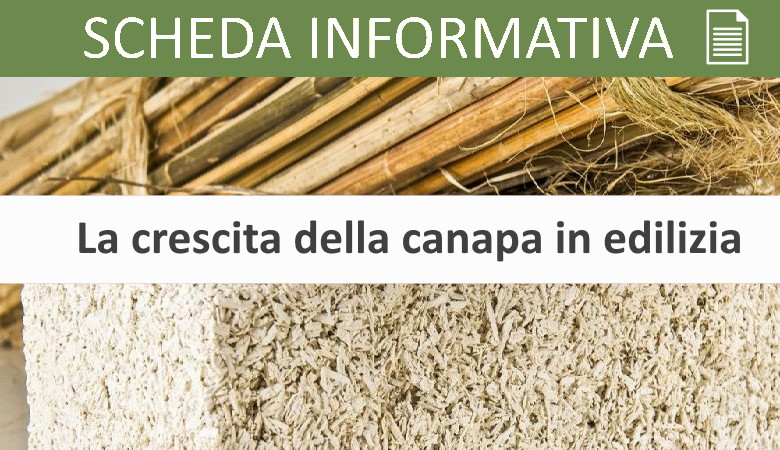The use of hemp for eco-sustainable products in construction is gaining increasing attention
In recent years, the national and international construction field has been witnessing a renewed interest in hemp. In fact, its biomass lends itself to a very wide range of industrial and artisanal uses. Between these, the production of eco-sustainable building materials.
Hemp is increasingly associated with eco sustainability concept, but it is actually based on a historically established tradition.
The origins
Its origins can be traced back to the Asian continent, while its spread in Europe dates back to before the advent of agriculture. In the Italian peninsula it was already cultivated in the time of the Etruscans and was widespread in ancient Rome, where it was used for the construction of sails for navigation, nets and ropes. In the mid-twentieth century, Italy is the second largest producer in the world with about 100.000 hectares of crops, but the economic agreements of the second post-war period penalized it by favoring synthetic fibers.
Ease of cultivation
The advantages of growing hemp are many: extremely resistant, it is a plant that grows without having to use fertilizers, pesticides or herbicides and remediation of the soil. Its dense growth cancels the development of infesting species. It is also excellent for growing on deteriorated land: indeed, it is able to absorb zinc and mercury, polluting substances. Among other advantages, it removes CO2 from the atmosphere and oxygenates the soil. It is also worth noting that in the growth phase, hemp captures four times the amount of carbon dioxide stored on average by trees..
Hemp & building
In one of the most "energy-intensive" sectors such as construction, hemp today represents one great natural resource with low environmental impact with a reduced consumption of "gray energy" in its life cycle. From its mass, both the fibers and the canapulo are used (the "hemp wood"). The former are mostly used in the production of insulating panels; while the second, mainly combined with lime binders, forms a multi-use bio-compound. It can be packaged on site or delivered to the construction site premixed to make vertical or horizontal castings, background screeds, filling of cavities, plasters or mortars; but it can also be used in industrial processes for the production of blocks or slabs.
In Italy, hemp-based materials they made a timid appearance at the end of the last century, with products from other countries. However, from about 10 years there has been an increase in their presence on the market, with a complete range of materials that has favored a growing number of interventions, such as the cases that are presented as an example of possible construction applications.
Technical characteristics of hemp building products
In the scientific field there are numerous studies characterizing the mechanical and thermal properties of hemp building products. For example, Walker & Pavia (2014) they found that the thermal transmittance [U] of a thick hemp-lime wall 300 mm is between 0,3 e 0,7 W / m2K , value that increases with the growth of the density of the material. The same wall recorded a soundproofing power of about 57 dB. These thermoacoustic capacities are favored by the high porosity of the hemp biocomposite analyzed, which is therefore able to absorb up to 80% of the acoustics and homogeneity which favors low heat transmission (Ronchetti, 2007). Several studies have also tested the fire resistance of the hemp composite, demonstrating that the nature of the material makes it resistant to fire without the need for specific chemical treatment (flame retardants); Il Building Research Establishment (2009) conducted a fire resistance test on a Tradical® 3m x 3m Hemcrete® wall not plastered or plastered: the structure exposed to fire resisted for 73 minutes while maintaining integrity, insulation and bearing capacity.
Hemp products used today
The most popular hemp-based building products concern:
- Hemp brick, composed of the Canapulo, the shredded stem of the plant agglomerated with dolomitic lime or NHL hydraulic lime 5, various additives and water.
- Mixed lime with hemp directly on site and used, as a plaster for both interior and exterior.
- Sound absorbing panels, used to insulate walls or attics.
- Lime and hemp plaster, natural premix, with excellent coverage and filling, suitable for shaving indoors and outdoors
Costs and the hemp supply chain in Calabria
The costs to manufacture in green building in hemp, they are even superior to traditional buildings, due to the absence of a stable production chain in Italy and in the various regions; the hemp and green building market however appears to be expanding and with the spread of its use; The Green Home Innovation Hub for Sustainable Construction, in particular, is a pioneer in this area in wanting to create a stable supply chain for the territory capable of networking every actor in the production process and use of hemp-based building products.
Sources
- ilgiornaledellartchitettura.it
- infobuildenergia.it
- elite-ecobuilding.it
- Walker, R. and Pavia, S. (2014) Moisture transfer and thermal properties of hemp–lime concretes. Build. Mat., 64: 270-276
- Ronchetti, P. (2007) Cement of hemp and lime: a promising material and construction method for sustainable construction
Download Form “Hemp in construction” (pdf)






